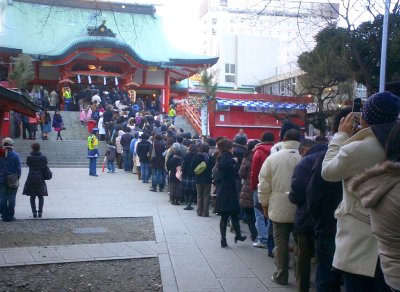New Year's Day is the most important holiday for many people in Japan, where anything “first of the year” bears a special value: first day of the year, first sunrise, first dream, first sales…
Traditionally, people put great effort into preparing for New Year's day, turning the house upside down cleaning it, and cooking special cuisine called osechi days before the turn of the year. Family members and relatives, as well as friends and acquaintances, gather for the occasion and exchange New Year's greetings. Or at least that's the way things used to be.
Blogger akane3 remembers how she used to celebrate New Year's when she was growing up and compares it to how her own kids spend the holiday:
昔の頃のように、古式ゆかしき伝統にのっとったお正月を過ごされたのは
はて どれくらいあるだろう・・・
私が幼い頃は、毎年のお正月にはお約束のようにして
親戚や知人がお年始の挨拶に来られて
それはそれは普段になく 賑やかな感じで まさにお正月!!っという特別な日だった。
御節料理だって、正月にしかお目にかかれない代物ばかり。
When I was a child, every year around New Year, relatives and acquaintances would always come to visit for New Year's greetings.
It was unusually busy and was a special day with a true New Year's feeling.
Osechi was also full of stuff that you would see only at New Year.
されど 時は平成、、、それも20年ともなると
御節料理も普段・・・しかも年中 お目にかかる代物ばかりの食材だし
飽食の時代の申し子とも云える現在っ子達には
めずらしくもなんともないようでして、感激の欠片も無いのが現状のようだ。。。
even osechi is made up entirely of ingredients that one sees everywhere, all year round.
Today's kids, who might be called the children of the age of gluttony, don't seem to find [osechi] unusual and are not thrilled at all. This seems to be the reality…
Kite flying is another common theme during Japanese New Year's holiday that has been changing in recent years. Blogger sorao, who lives in a rural town in the countryside, shares what she saw while taking a walk on New Year's day. She writes:
農道の向こう側で小学生低学年くらいの子供2人とお父さん・おじいちゃんらしき人が凧揚げをしていました。
子供2人は手作り凧をあげようと奮闘していてとても微笑ましかったです。
遠くに出かけるばかりではなく、こういう田舎の田んぼ道で凧揚げを楽しむお正月も良いものだな、と思いました。
These two kids were trying hard to fly a hand-made kite and I found it very cute.
Rather than travelling to a distant place, spending the New Years holidays flying a kite on a rice field path in the countryside is also nice, I thought [to myself].

Hatsumode: a long line of people at Hanazono Shrine, Tokyo
Unlike other New Year traditions, hatsumode, or first visit to a shrine or temeple, is sill quite popular among many people. mmpolo, who used to go to four local shrines for hatsumode, recently found out about the history of this tradition and has changed his yearly custom:
さて、先頃正月に神社へ参拝する初詣は日本の古い伝統行事などではなく、明治になってからある鉄道会社が始めたものだと知った。ヴァレンタインと同じだったのだ。それを知って今年から初詣を簡略化することにした。4社のうち吾嬬神社だけにしたのだ。
そういえば江戸時代の話にも浮世絵にも初詣は描かれていない。賢い鉄道会社の社員がいたものだ。
By the way, I recently found out out that Hatsumode, a custom in which people go to a shrine and pray at New Year's, is not an old Japanese traditional event, but was started by some railway company in the Meiji period. It's like St. Valentine's Day. Knowing that, I've decided to simplify my Hatsumode from this year on. I've decided only to go to Azuma Shrine.
Come to think of it, Hatsumode is not mentioned in either stories from the Edo period nor in ukiyoe. What a smart railway company employee.







1 comment